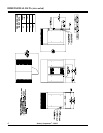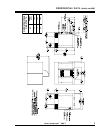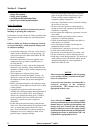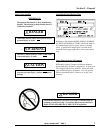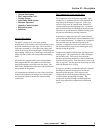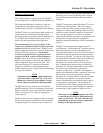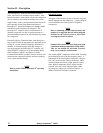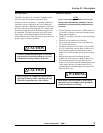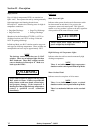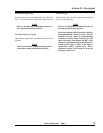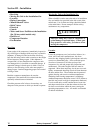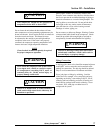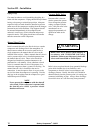
Section II - Description
Quincy Compressor
®
- QSD™ 11
Capacity Control System
The standard method of capacity control for the QSD
™
oil-free compressor is Continuous Run with load/no-load.
The Continuous Run Mode of operation is ideal for a
compressed air system that will operate at full load
conditions most of the time, with minimal unloaded time.
The QSD
™
allows very consistent and tight control of air
system pressure by constantly monitoring package
discharge pressure and operating within a deadband of as
low as 5 PSI. This means the system pressure never
needs to fall below the normal required pressure.
The recommended receiver size for a QSD
™
oil-free
compressor is a minimum of three (3) gallons per rated
compressor CFM; the more the better. If there is more
than one compressor, the receiver must be sized based on
the total CFM of all compressors. This should be
increased to a minimum of five (5) gallons per total
compressor CFM for systems with sharp changes in
demand. The receiver must be located immediately
adjacent to the compressor and before any additional
system components such as dryers and filters. This
allows the Power$ync II
™
controller to operate the
compressor coincident to system demand changes
without dramatic episodes of rapid loading and unloading
(cycling) of the machine.
NOTE
Continuous operation with rapid load/no-load
cycles will reduce component life. Cycle rates
should never exceed six (6) per minute. Proper
receiver sizing is essential for reliable operation.
The QSD
™
does not use an inlet valve, but rather the
patented Power$ync
®
lift valve technology to unload the
machine. With this type of control, the unit is operating
either at full capacity or 0% capacity, depending on
system pressure.
Suction or inlet valves on competitor designs act to close
the inlet to the compressor and induce a vacuum in both
compressor stages as it continues to try to compress air.
This vacuum creates a reverse pressure differential across
the bearing seals, causing the bearing fluid to migrate
toward the compression chamber when the machine is
unloaded.
The QSD
™
incorporates patented Power$ync
®
lift valves
on both stages of compression. The valves, one per
stage, actually relieve the compressor stages ability to
compress air. Because the unloading is positive, and no
vacuum is created, unloaded horsepower is minimized.
Also, since the compressor stages are not creating a
vacuum in the unloaded state, there is no tendency for the
bearing fluid to migrate toward the compression
chambers, reducing the likelihood of fluid contamination
of the air.
The QSD
™
loads and unloads in response to the air
system pressure. The Power$ync II
™
controller monitors
package discharge pressure into the compressed air
system and either opens or closes the lift valves to load or
unload the compressor, based on preset pressure values.
Upon start-up, the QSD
™
will operate at full capacity up
to a predetermined maximum value, usually 5 PSI above
the normal plant air system operating level. The
blowdown valve and both lift valves are closed at this
time. When the preset pressure value is reached, the
Power$ync II
™
controller opens both lift valves and the
blowdown valve simultaneously, reducing the
compressor output to 0%. The QSD
™
will continue to
operate in the unloaded condition, with the lift valves and
the blowdown valve in the open position, until the
Power$ync II
™
controller detects a reduction in pressure
indicating a reset condition. This pressure, like the
unload, is determined by the customer, based on the air
system operating requirements. The Power$ync II
™
controller reacts to the signal by closing the lift valves
and the blowdown valve, thus reloading the compressor
and returning to 100% output to complete the cycle.
NOTE
If the stage two discharge blowdown valve fails
to open an excessive pressure differential across
stage two will occur. The unit will shut down
automatically to prevent excessive temperature
build-up in the stage two airend.




